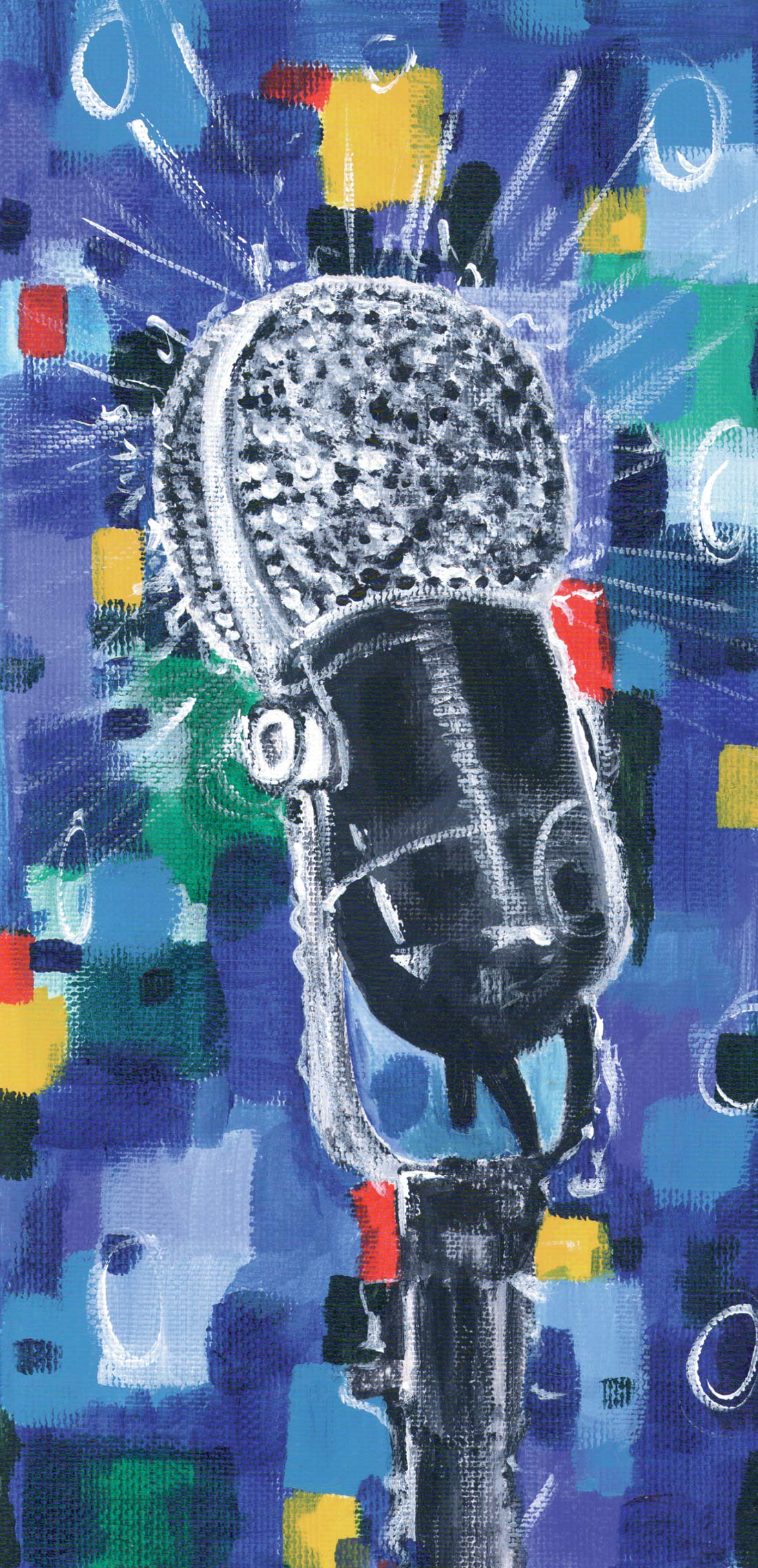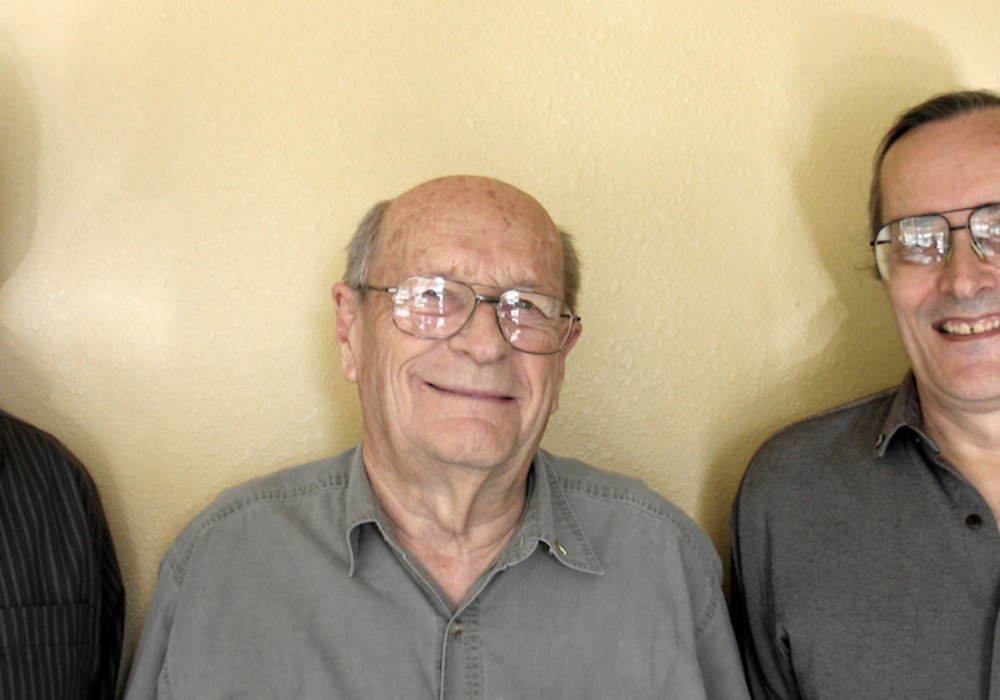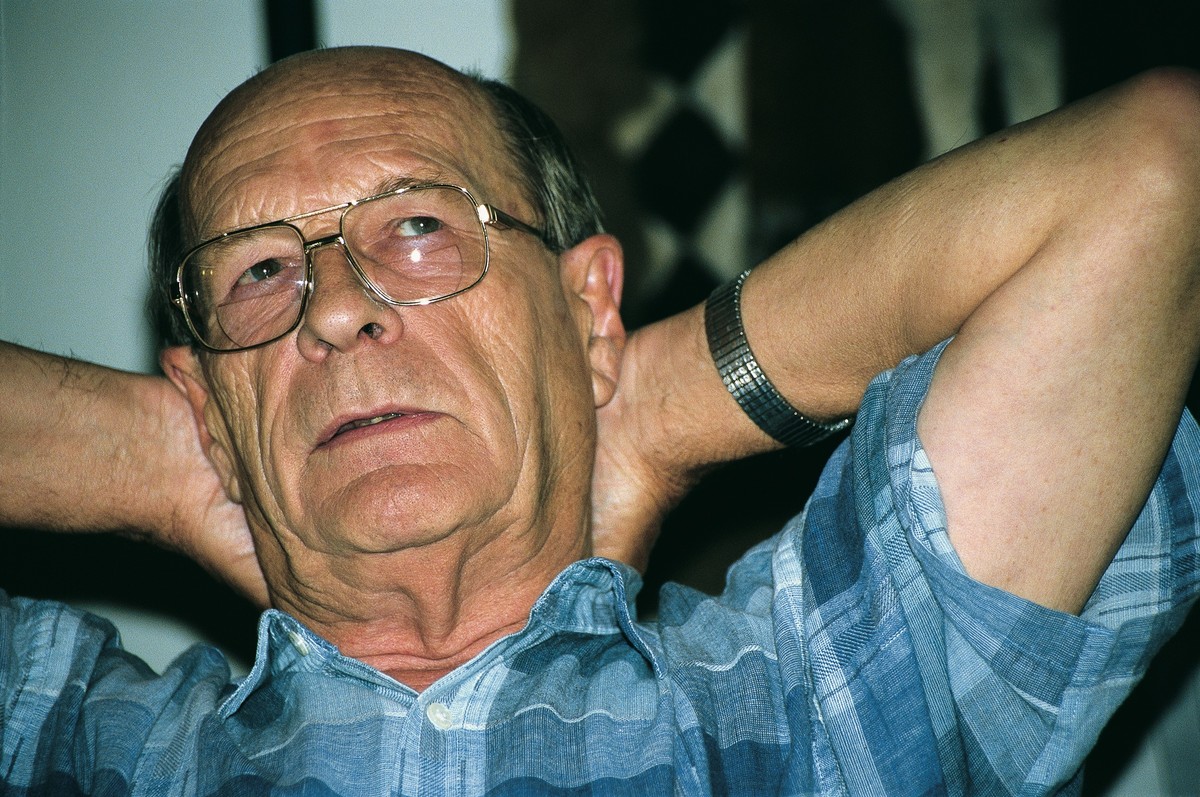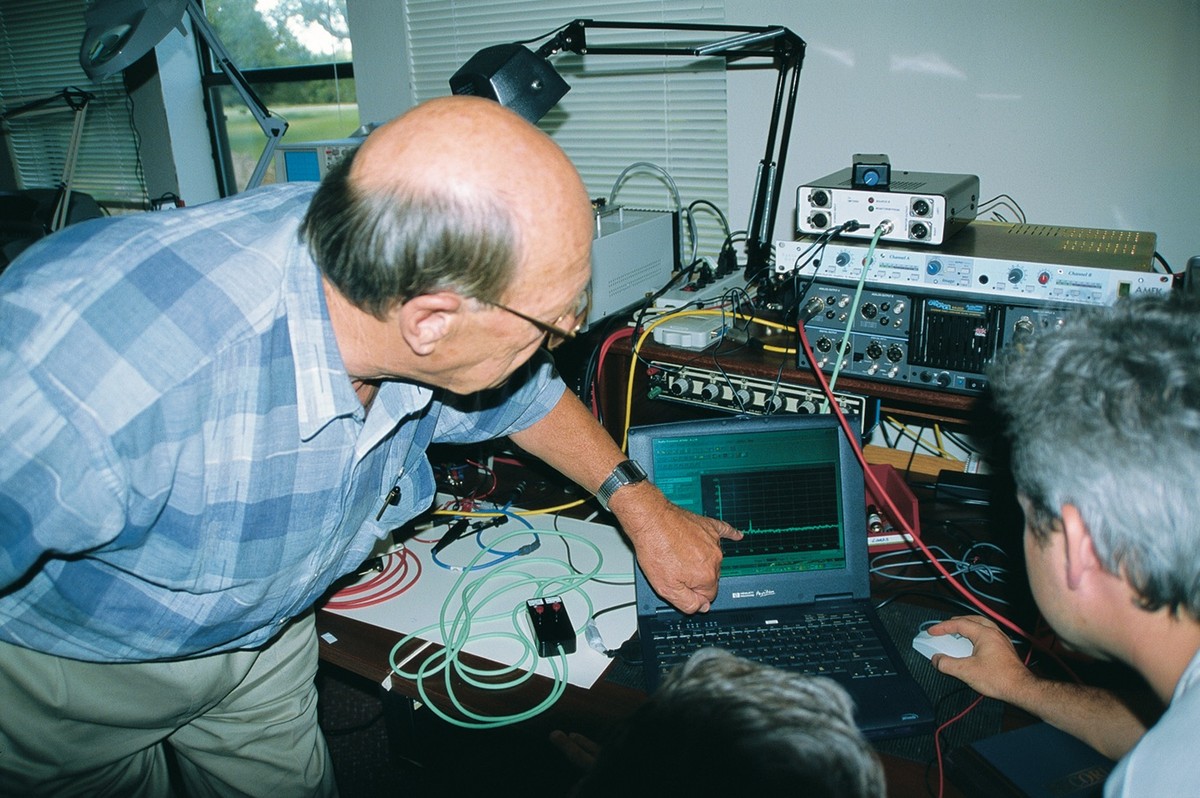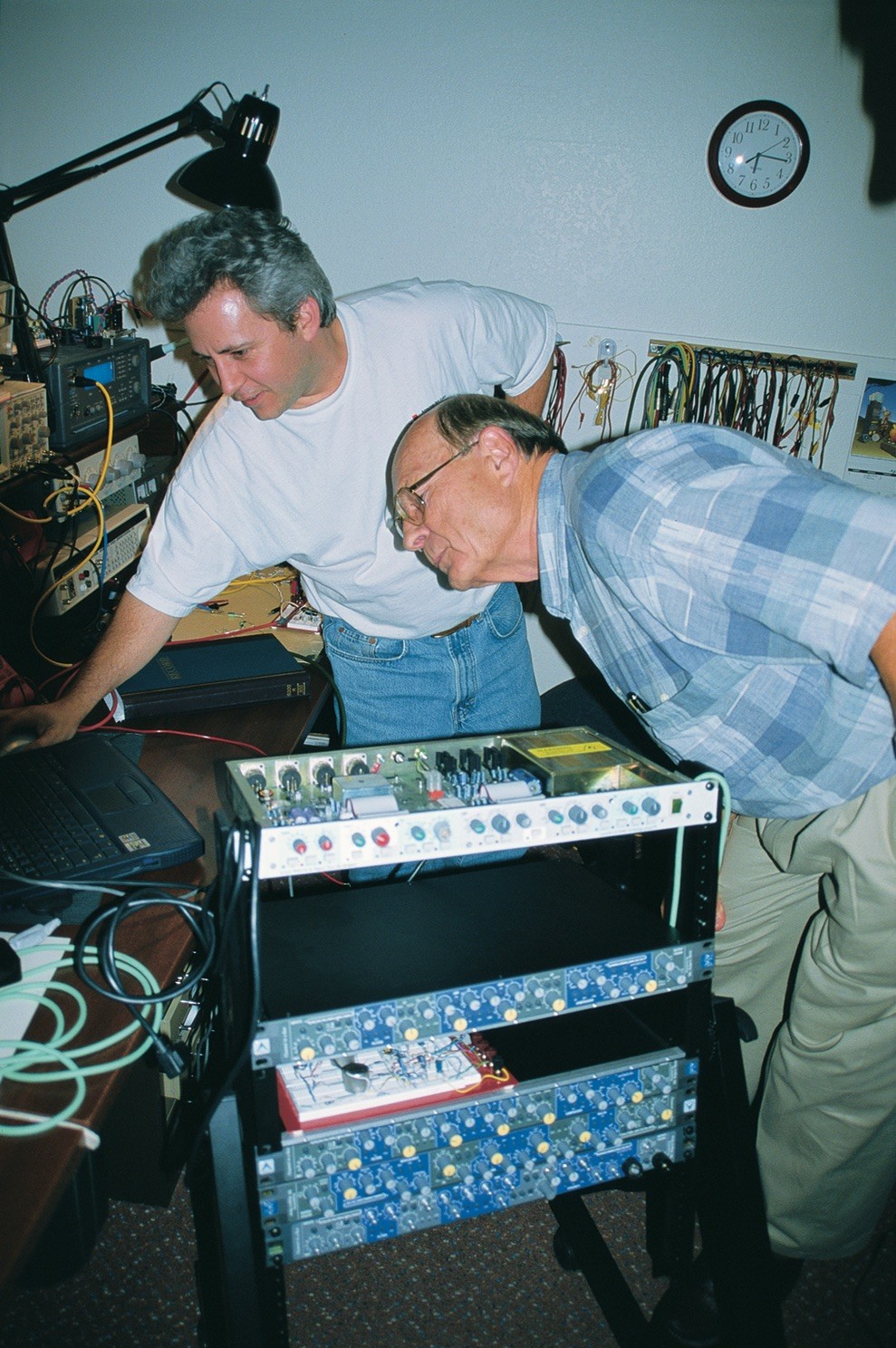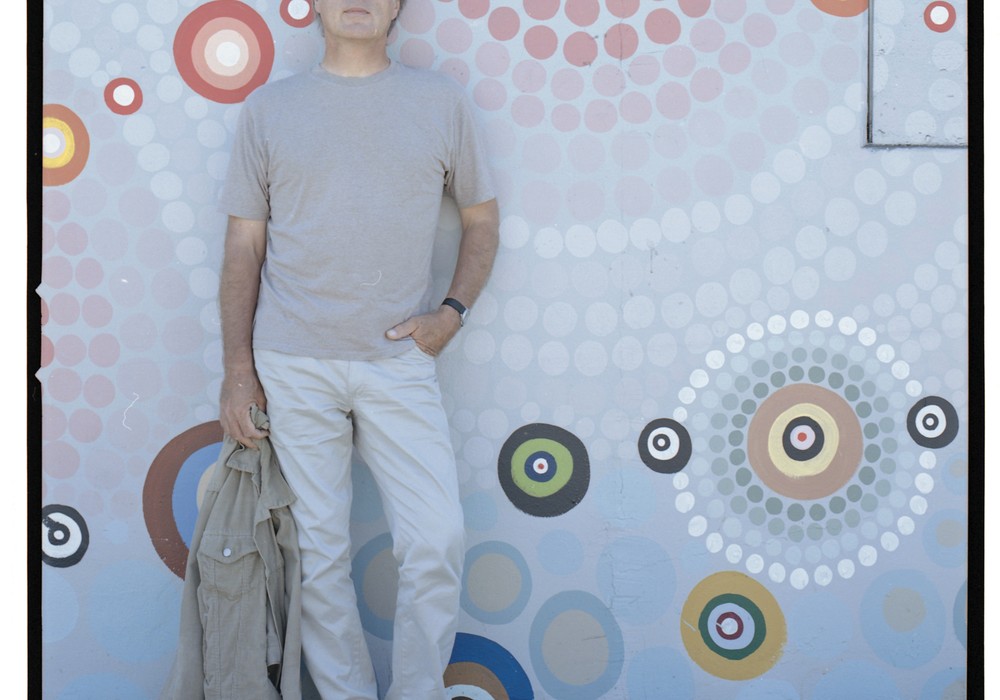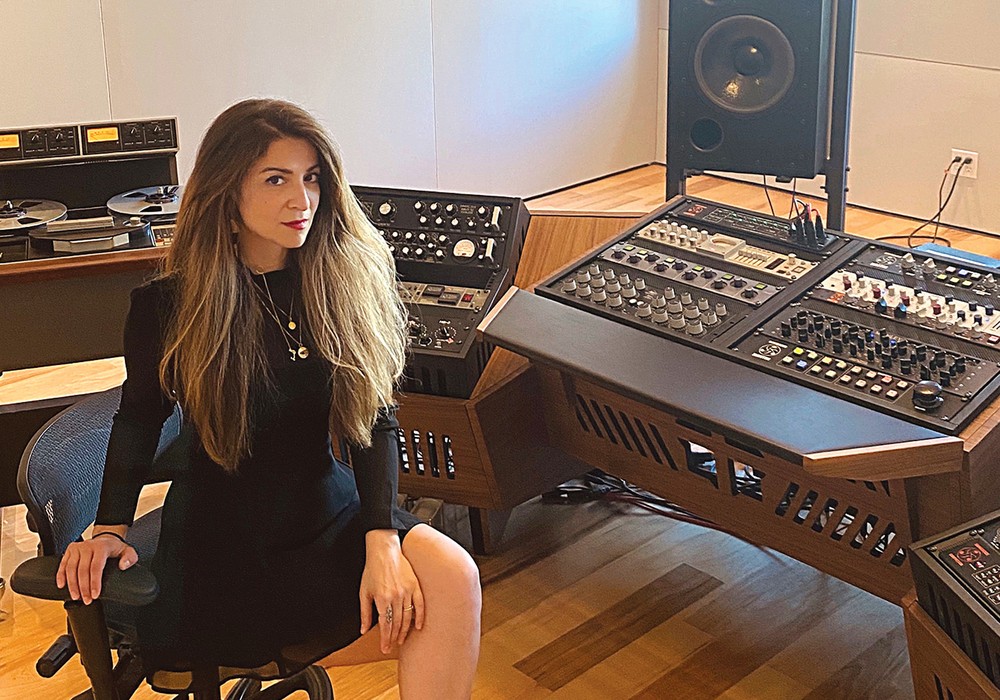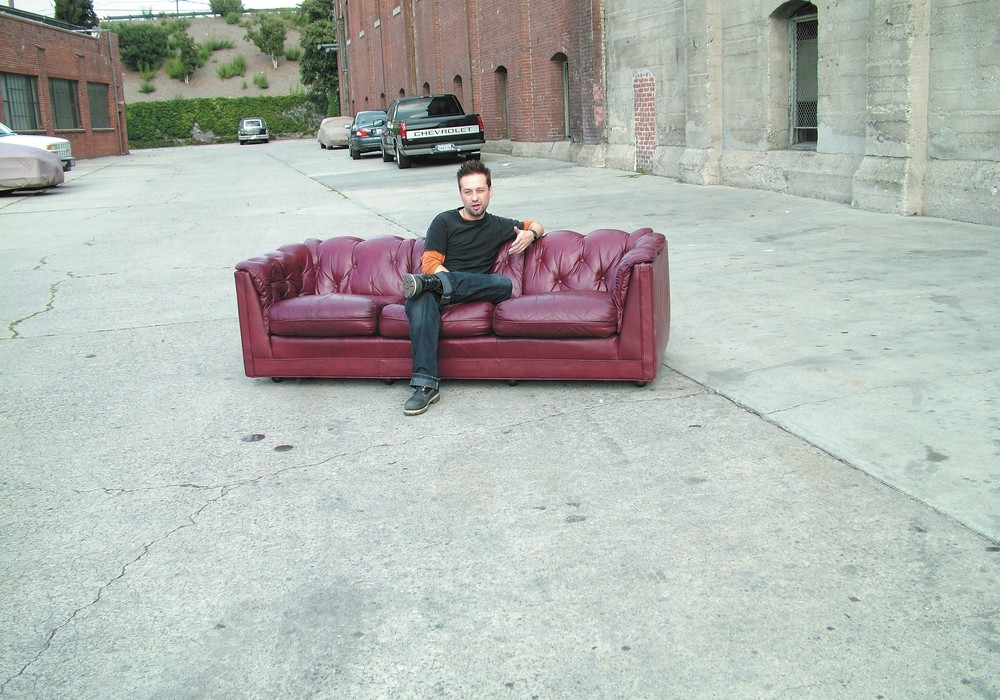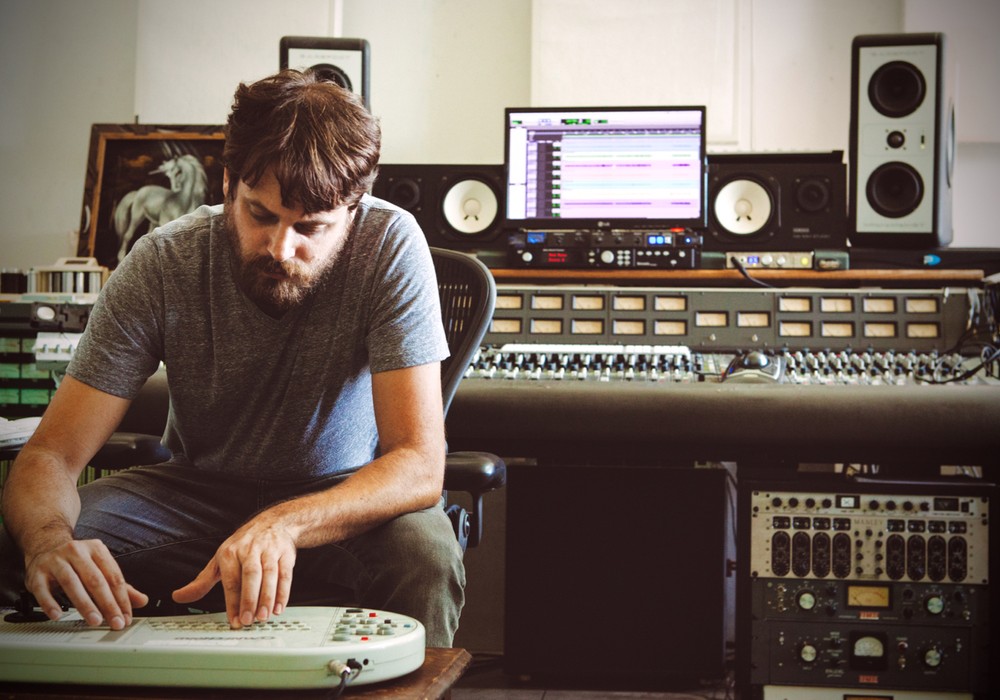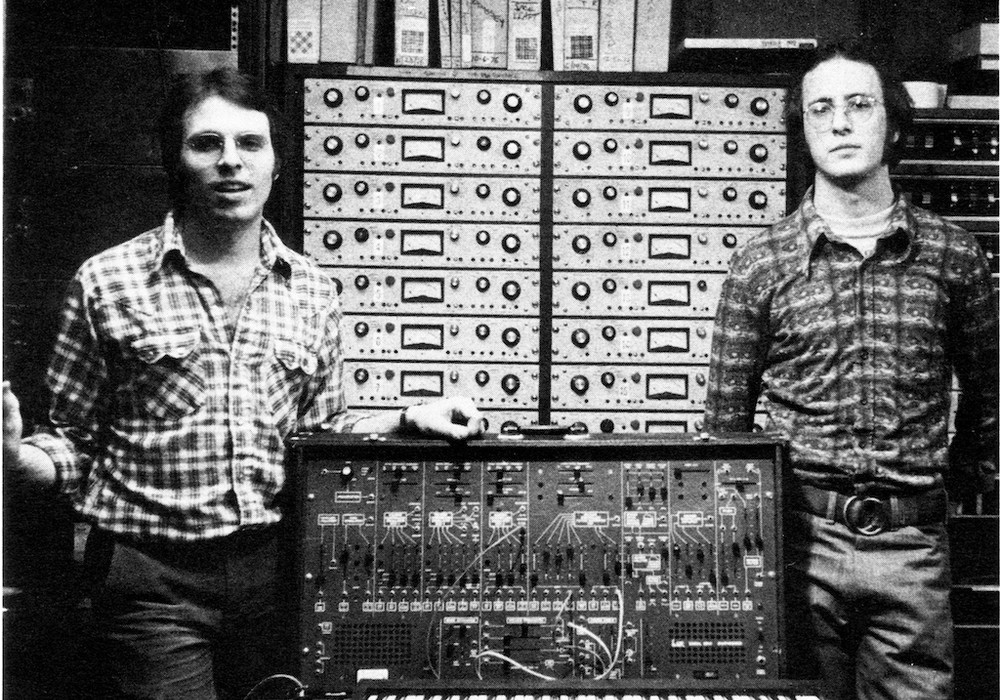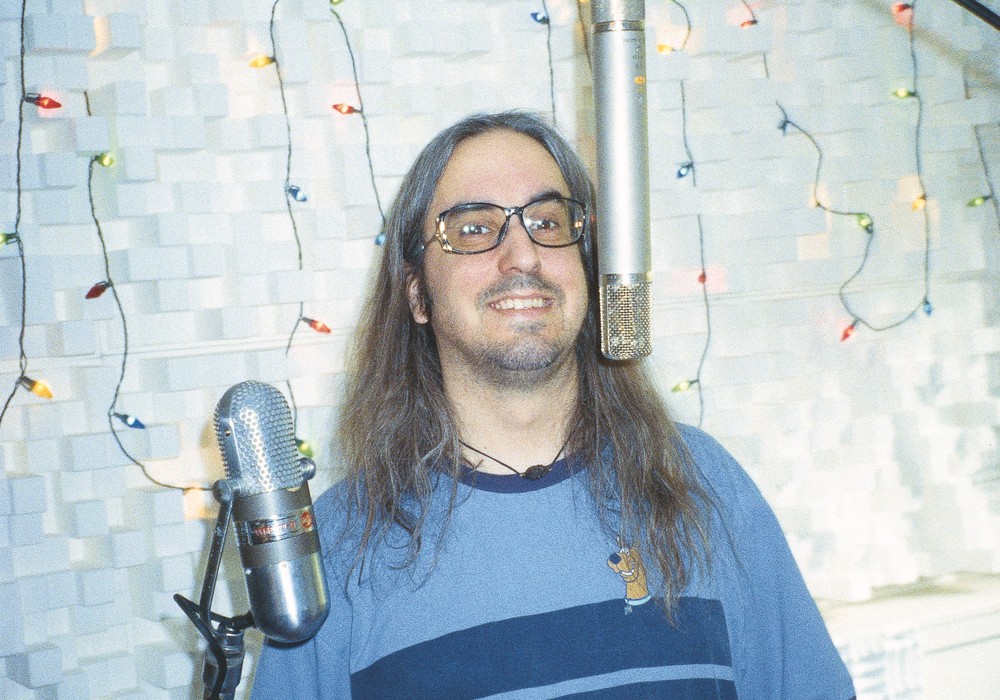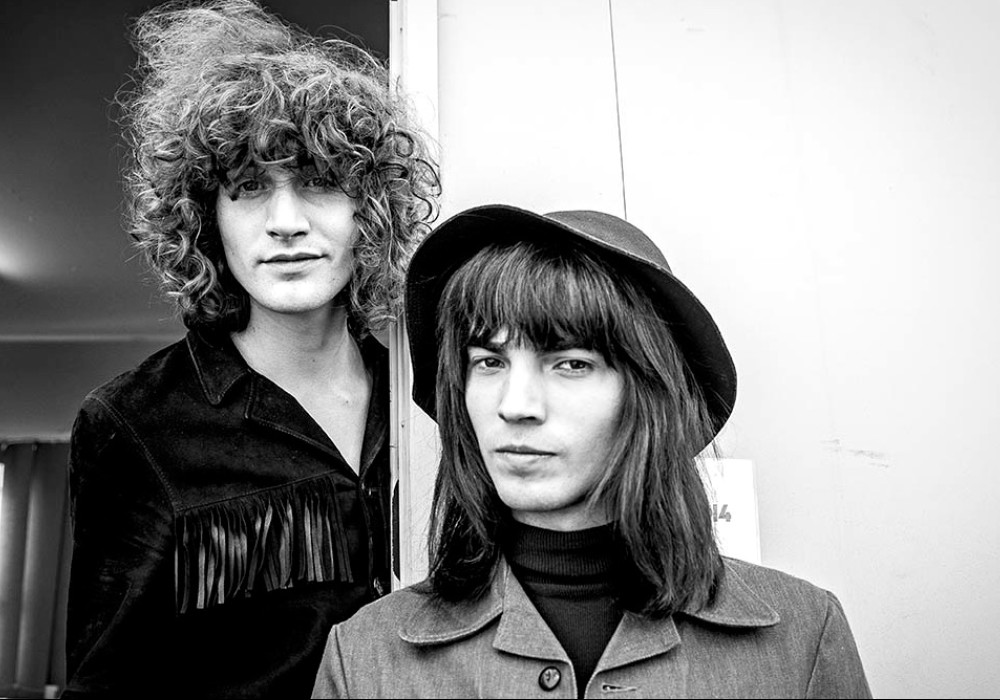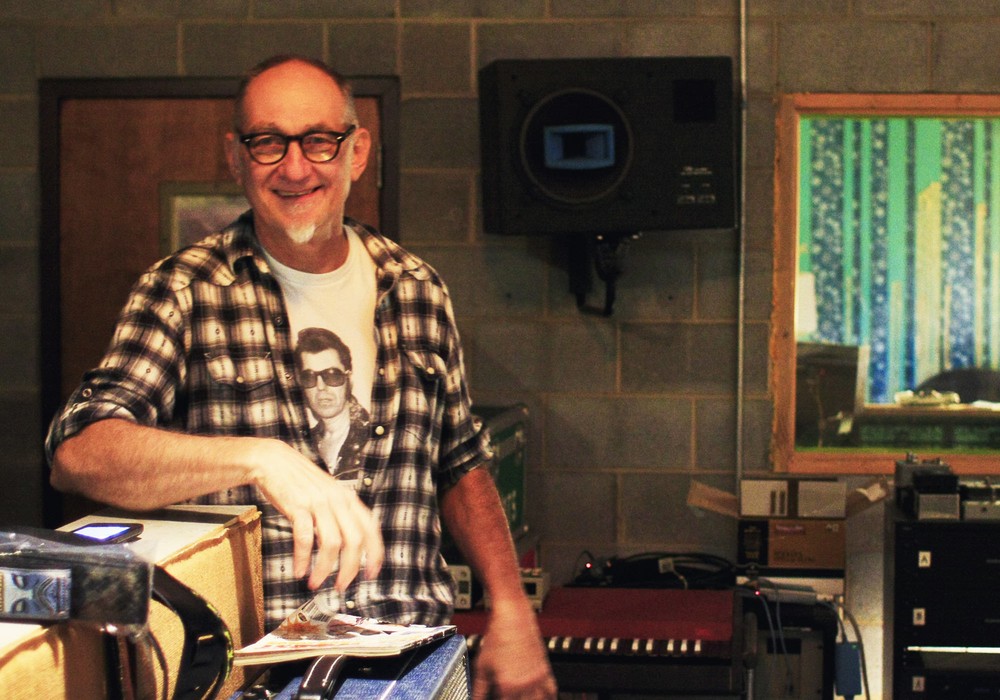There is a humble man who lives in the small town of Wimberley, Texas. His name is on recording consoles all over the world, and so many important works of music have run through his signal chains that we don't even need to mention them. He is still designing recording gear, such as the fabulous "Channel in a Box" by Amek. The things he builds sound musical, which is what this is all about, isn't it?
(Also present at this interview were Rupert's assistants, Mark Phillips and Kevin Burgin.)
SM: You have done some sound recording but it's been a long time.
It's been quite awhile.
SM: Why?
Well, first of all I have to earn a living. Just after WWII, I was running a little recording/public address system. We used to record brass bands, male voice choirs and choral society during the Winter, and we used to do public address for shows in Summer. When I met the girl I thought I would like to marry, I had to go and talk to her father. He was a very strict, Victorian type of gentleman and he sat at one end of a table that seemed to be a mile long and said, "What do you do for a living?" I said, "Well, I do recording." He said, "You do what?" He'd never heard of it. To him, a recorder was a gentleman who sat in a courtroom and wrote down the proceedings. "No, no, I'm not a recorder, I do recording" and I explained from the ground up what it was." Bear in mind that in those days there were no such things as tape recorders, we had just emerged from the war and I knew about tape recorders, but we were using 78 rpm disc recorders, recording onto acetate. So I had to explain to him what I was doing and he was not at all amused, thought that was a tragic case for a job. He said, "I hope you'll get a proper job. Come back to me in a couple years and see how you're getting on." I didn't want to wait a couple of years. Doing recording was great fun. There were about four recording studios in the whole of the United Kingdom at that time. I didn't have a studio, we had a room which we used to rent over a music shop. Of course we recorded straight to disc. There was no second chance, so you had wasted your blank if you didn't get it right. So I went and got a job in London with a company that ran cable-radio. I found myself designing amplifiers, pre-amps, and making it sound good, doing equalizing on the lines and so forth. I found myself more or less in charge of the audio of the group and learning electronics. But the sound always interested me. I had to go into transistor amplifier design, which was a whole new thing. I was working for a company that was making transformers and I became the transformer designer — the guy who'd been designing transformers came to me one day and put this book on my desk. I said, "What's this book?" He said, "That's a book on transformer design." I said, "Why should I be interested?" He said, "Because you're now going to be the transformer designer for the company. I'm leaving." [laughs]
SG: That was your introduction to transformers?
Yes. So I read the book and I called the different suppliers, got a lot of cooperation from those chaps. I was in close contact with a couple of people whose names, in those days, were really the top of the transformer field. Brian Savage and Mr. Partridge. Before the war Partridge Transformers were very famous, high quality. I went to see these people, they were all very gracious, and taught me what to look for, how to do it, and I got bit with the bug. Then I became chief, and in fact only, designer for this small transformer manufacturer, and saved some money when we found we could manufacture transformers which worked just as well for half the money we were previously spending. I worked on new insulation materials — all transformers in those days used paper insulation, sometimes varnished or waxed, and this limited the temperature that the transformer could work at. If you went too hot it would carbonize or burn — not a good idea. I found there were passive materials that you could use which could take much higher temperatures and were just as cheap and were actually easier to use. I got manufacturers to make it and this insulation was far better than paper. Manufacturers started coming to us to get high quality transformers at lower prices than they had been paying others. Even in those days high-quality transformers were expensive. It all added together when, finally, I left that company and started on my own. The first thing I did was design a bookcase-style speaker. It was one of the very earliest high-quality, small size speakers. High- quality in those days meant huge, great big corner cabinets with sand-filled baffles and goodness knows what. They sounded terrific but were not very practical. Anyway, it was the first of these and we got good reviews on it, and it sounded nice, but again, there wasn't any money in it. This hi-fi, people just didn't know what it was about. The UK was 2 or 3 years behind the US where hi-fi was becoming established — this was in the late '50s. In England the houses were smaller, budgets were smaller, people didn't have the same interests, and it was very hard to get anybody to buy stuff you were making, whether it was good or bad. Slowly that began to change. I already had some contacts, and one studio owner in London commissioned a mixing console, which was tube. And he liked that, and then we built him another one, and he liked that. In fact, at NAB the other day, a gentleman who collects these things came back and showed me a photograph of Number 2 — he'd bought it.
SM: Is that the 10 channel with the dials?
That's it.
SM: I've seen it on the web. [www.socalproau- dio.com/consoles.html]
Oh, he's put it on a website? Well, that we sold for 450 pounds, and he paid $27,000 the other day.
SM: I'm not surprised. SG: How much work went into it — how long did it take to put together?
Three weeks. [stunned silence — mouths open] It worked well — in fact, that particular console was actually working and in use until about a year ago. About 3 years ago I was in Singapore and they showed me a console which I had sold them in 1967, this was a semi-conductor console, one of the very early ones. And they had it all polished and clean and so on. I remember selling them that console and I sort of put out my hand and was stroking it and they told me not to touch it. I asked, "Well why not?" They said, "It's on air." They'd maintained it and looked after it, but these things just go on and on and on. So, it was a good opportunity as there was no competition. There were German makers of consoles and a couple of British makers — none of them would qualify today as quality products. The Germans built meticulously engineered, beautifully made stuff, but very clunky, very difficult to use and they were very arrogant. This was just at the start of the pop revolution and so studios and engineers began to know what they wanted and they would go to the current manufacturers who'd say, "No no no, you cannot have this, this is not the way we do it." And I had the opportunity of talking to these folks and finding out what they really wanted, why they didn't go to the competition. And we built consoles. For a number of years everything we built was custom-built. We got a reputation, and did it well. Because we were so scared of a thing not working, we'd over-engineer it. Leo Fellini, who had ordered the two tube consoles, specifically at one point asked me, "Have you heard about these transistors." I said, "Yeah, I've heard about them." "Will they ever be any good?" I said I didn't know, and hoped not or I'd have to learn all over again. But I quietly went back and bought some transistors. Didn't like them at first, but then I had a breakthrough. I was designing microphones for the Royal Air Force. Stuff for use at high altitudes — not high quality but very durable. And the mic they were using was a carbon mic which has a very high output and is very reliable, if it goes weak you can give it a shake or bang it and it starts up again. But it does not like high altitudes. I was talking with the Ministry of Aviation officials and they were laying down all of what they wanted. I asked, "What is your actual objective?" And one guy says, almost as a joke, "I want to talk to people on the flight deck as easily as they're talking across this table now." I said, "There's no reason why you shouldn't, but can you pay for it?" We did a carbon mic and a rocking armature mic, then I went to a collar microphone but it had no output. Aircraft are full of high current cables running everywhere, all electrically operated, big solenoids, great big spikes everywhere Noise, noise, noise. So the carbon microphone had the advantage that it was low impedance but high output. So to get high output from a moving coil we had to give it an amplifier. There was no way we were going to give it a tube amplifier, so I started on this transistor design, and after a bit I found that you could actually do things. We made it, electrically, look like a carbon mic 'cause all the aircraft were equipped with carbon mics, so you could plug it in and it would be fed to the same volts and currents and so on, same output level, and they were just over the moon, it was great. Then they discovered that the moving coil unit was made in Austria and said, "We can't buy them, we've got to have them from the UK." But nobody else made them — so we either had to buy enough to see us through the next great war, in case Austria was on the other side, or buy the rights to manufacture them. So I said, "What you need to do is buy enough and get the drawings..." That was where I first met Bernard Weingartner. Bernard was, at that time, the chief designer at AKG. He started Neutrik sometime after that. They'd make a huge number of moving coil capsules and they did them quite cheaply, about 3,000 per week — aiming mostly at the European telephone market. They would have a quick scan of response and sensitivity, then bin them, the top bin being the high quality mics for recording, the bottom would be for telephones, and we got something in-between for the R.A.F. But it was all the same design.
SM: When you are testing gear — say an EQ, what are you putting through it — test tones, music, both?
Well, we listen to music mostly, there's some favorite stuff I listen to. But it's so predictable.
SM: How so?
Well, first of all the original concept still comes from the position, not from me. They tell me what they want, a bit of this or a bit of that, then I come back and play around. For a quick check of what it's doing I will either use pink noise — which is very revealing — or put it on the scopes and see what it does. We've got frequency response, which is sometimes regarded as not that important, but a 1/10 of a dB deviation in frequency response in the 20 Hz — 20 kHz range can make a very subtle difference to the sound. We have to make sure that it's either dead flat (quite beyond those limits) or we have to know why it's not flat. You take most present-day equipment and they don't work to those limits. They say it's flat, yes flat within a dB, even half a dB, sometimes better, but when you really get down to it those little differences — the golden eared people can hear it — they might not know that it's a frequency response but they know that it's different. They either like it or don't like it. The greatest satisfaction that I get is when I have a new piece of equipment and somebody who really knows, a really golden eared person is playing with it. Occasionally it happens. You find that the EQ, which might have a range of +/-18 dB, and he's moving it just a fraction off flat. I've had this, I suppose, three times. Once, way back at AIR Studios with Geoff Emerick [Tape Op #57], I was doing just that, checking out the EQ. Other people had already checked it out and they were winding controls back and forth saying, "Oh listen to that, listen to that bass", but Geoff had everything flat, then started moving just a tiny fraction and he'd say, "Ohhh, would you listen to that!" It was doing what he wanted it to do. The last time it happened was in New York about a year and a half ago when the Summit unit was being demo'ed at Sam Ash. Frank Filipetti came in. I didn't know he was going to be there but he came. I know the guy, he's one of the top golden eared people, and he says, "Well, what's this we've got here?" I told him the improvements we'd made and he did exactly the same thing. He'd brought a CD of his own (and I don't think a CD is the way to go with these things but he had just finished it) and he just moved the knobs ever so slightly. He said he wished he'd had it a week earlier when he'd been mastering the disc. He didn't appear to have done anything — that was the acid test.
SG: I've heard a lot of stories about Geoff Emerick's ears.
Well he still does that. I'm sending him some new stuff to see what he thinks of it.
SM: Would you like to weigh in on the analog/digital debate?
Well I suppose digital will be okay one day. But you've got more than a generation of people who've grown up with compact discs and do not know what real sound is like. They don't go to concerts. So they have no basis of comparison. They've grown up with digital and so digital sounds okay. But the resolution just isn't there. You cannot get proper separation from a stereo channel, digital just won't do it. Just try and envision what happens with a 10 kHz wave form with some harmonics in it — you can't resolve anything above the second harmonic anyway, and now if you slip that between two channels what's it going to tell you? Nothing. There is no separation. So the limitations of the current systems are well known but they represent a quantum step forward in usability compared with the LP, the cartridge and the messy noisy disc. If you keep your stylus replaced it is extremely good, in fact I'd prefer to listen to vinyl anytime. But it is a convenience, a fast-food type of approach that is very successful. Not very nutritious. Now we are moving away from that. The digital designers themselves are not audio people. We had a certain company (we won't mention names) come here one day last year with a new converter they wanted me to endorse. The dynamic range they quoted was 120 dB. The dynamic range we measured was about 106 dB. They wanted to know how I was measuring it — the only way I know how, audio in/audio out — that's what counts, that's what you're hearing. They wanted to know if I could measure it in the digital domain, and I could, but that doesn't tell anybody anything. So they then wanted to know what dynamic range it should make. Well, a big console, say a 9098, has a range in excess of 126 dB — why should we settle for anything less? And if we ever felt threatened we could shoot it up to 140 dB. In that bracket, dynamic range is not the most important parameter. There have been recent tests on frequency response well in excess of the audio path. They show the brain actually reacts against the restriction of frequency response with the electro-magnetic brain-waves that are associated with frustration and anger if it doesn't get the frequency response associated with the signal it's supposed to hear. Now it doesn't happen with everybody because it's working against a databank. If you have a stored databank of knowledge of what a concert in the best hall sounds like, you're comparing it. Your decoding mechanism is taking care of that and it is saying it is not the real thing, it's got stuff missing. Now you couldn't listen, then sit down and write, "I think that the frequency response is 3 dB down at 35 kHz", but the brain actually knows that and compares against the databank of experience. It simply reacts, knowing it isn't right, it doesn't fit. Having said that, there are systems coming along now which do give us the frequency response, quite adequate dynamic range, and actual harmonic distortion. I could show you FFTs of quite well known amplifier stages that come with wonderful figures but you'd be horrified with what they actually do. Compare that with the refined version and the sound is better, cleaner, more solid — truer. Interesting thing is if you start with sound quality which is very good, that will reflect right through the digital system, you can hear it, even through radio transmission.
SG: Don't you still end up with the problem that no matter how much you expand the frequency response it's still going to end up on a 16-bit 44.1 CD? Won't you still lose echo and reverb tails if you go to that format?
Well, if you do that, that's what happens. The Sony single bit streams have a 100 kHz playback and 120 dB of dynamic range. I have to take my hat off to them. They've got this dual CD player which will accept both types of CDs. So you buy their super- expensive CD player and you've got this wonderful, really good high frequency response, low distortion, low noise — it's enough to satisfy even me. But if you don't have the discs the same piece of hardware will play a 44.1 — I think it's a brilliant piece of marketing. If they make it stick my respect will be enormous. I see now that JVC — who were the originators of that, by the way — has come up with a system. I haven't heard it but JVC are one of the best of the consumer audio people. I was in Japan at a press conference, and I get asked the question all the time of what do I use for listening, and I usually don't discuss that. I'd been evading this question. Finally I saw no way out, and through an interpreter I said, "I just use a very ordinary hi-fi system with a JVC amplifier." And there were a bunch of engineers from JVC at the back of the room and they started jumping up and down and shouting, "What model? What model is it?" They're about the only people who understand to not present a piece of equipment with crossover distortion, and simple things like that. The noise floor isn't as good as I'd like to see it, but it actually sounds better than most. And a darn sight better than 85% of the hugely expensive, real high-end audio stuff.
SM: What kind of future do you see for analog tape?
It's being increasingly recognized as a really worthwhile medium. The medium itself is improving. I'd like to think the recording process will improve as well. There has got to be a demand for it. At the moment everybody is all starry-eyed about digital, and that's okay, it's improving, but I think there are tape improvements that could give us more dynamic range and wider frequency response. I've often wanted to get into it myself but I've never had the time or opportunity.
SM: Despite the current love of digital, I know quite a few engineers who went down that road, hit the wall, and have come back to embrace analog. Consequently, the gear has shot back up in value.
SG: Or they've got Pro Tools and have realized they need a high quality front end.
You mentioned Pro Tools. The processing power is limited, it's not a very good mixer. Most of these digital devices are not. The other thing is that a lot of that is at very low levels. We have a device coming to market fairly soon which depends on very high resolution in the "threshold" area. There isn't any digital device that can do it. We're limited to that last significant bit resolution and the thing starts to dither. We need to go a lot further with digital before we can do some of the tricks we can do now. People don't realize this. They accept that it doesn't work as well, sounds flat and uninteresting, but use it anyway.
SM: Do you think we're more critical or more relaxed concerning how a device sounds?
A hard one to answer without qualifying. I don't think we're more critical because I don't think people have the point of reference on which to base a true comparison. But it depends on who you are. If you're one of those who buys a car and only inspects how big the speakers are in it...
SM: Are you surprised to know that people like to overdrive your old Class A gear?
I'd be surprised if they actually overdrive it because a feedback amplifier has similar characteristics, whether it's Class A or any other class. A lot of people attribute Class A to amplifiers which are not. We've just started a website, rupertneve.com. It will be up in the next few months. We get a lot of questions like, "I've just bought this console, do you remember it?" What they don't realize is by 1978 between SSL (our number one competitor) and ourselves we were selling 25 major consoles a month, and hundreds of smaller ones. It was quite impressive. Between 1971 and 1981 there were thousands of consoles built. What we'll be trying to show on the site are the base configurations and designs of the different vintages. The very original transistor designs were germanium transistors and they were certainly all Class A. We then went over to silicon transistors, and keep in mind these were very difficult to get. In 1965 the only germanium transistor that came anywhere near low-noise was made by Texas Instruments (I still remember it was part #23309). These cost us 2 1/2 pounds each (currency rates were roughly $3 = 1 pound). I would call up the TI folks in the UK and order a hundred (two per channel x 48 channels), but they only got an allocation of 24 every three months — even at that price. It was a constant fight. I had to call friends in the US to see if they could get them. That was how difficult it was. Eventually we got away from those. There was a UK manufacturer that started to make transistors. When we found them we were in desperate need of a hundred. My wife went across to get them and came back with the transistors but she was very worried. She wasn't sure they'd be any good. They were stamped with the type number right as they came off the line — they could have been anything. They worked, not quite as good as the Texas ones, but they worked. They never, in my opinion, sounded as good. A lot of the consoles from about 1970 onwards made use of these. In the mid- '70s we got a lot of the chips. So we have three different categories, basically, but the golden oldies are the best.
SM: Truly?
Yes, we can show it. We just sent off today some items that were loaned to us ('cause I can't afford this stuff) from Fletcher at Mercenary Audio [a pair of 1064 modules]. All original. There's something about the character of the sound you just like, though it's very hard to measure the differences. In fact, when we measured it we thought, how in the world did we make it that good in those days, especially when we didn't have the gear to measure it with? We're now going back full circle. We'll have new stuff that will have an old school-type of technology.
SM: That's great. Any ETA?
Oh, a year or so.
SM: When you are designing something you've done before, a mic pre for example, how do you approach it freshly?
It's not easy to give a general answer. First questions: What is the mic pre for, what sound pressure levels do you want to cover, what kind of mics will be used, etc. We would then adapt circuitry we've done before, look at the devices that are currently available, then put together a design that would suit the application. My main interest has always been in high quality recording of real sound — classical music, choral music, and so on. I would always try to give you the best quality that the job deserves. Originally, the first semiconductor designs we had had a hard job getting low noise, which we used to get with tubes. Today that isn't a problem. It's a question of providing a range of gains which will suit most of the applications and different microphones so that we might have a general market. And to an extent, the design is not a cheap one and I'm not interested in doing a cheap design — you get the best that I can do for the application. Having said that, the mic pres which we are currently using all have a very close resemblance, because once you have a good path you don't want to go away from it too much. We change the devices from time to time, find better ones. Kevin spends a lot of his time in contact with the people who manufacture these devices so that we're out there all the time with the best — not just the latest, but the best.
SM: When was the last time you used a slide-rule?
[laughs] Let me see — about 1978.
"The beauty of most Neve modules is that Rupert Neve (everyone on your knees and salaam toward Texas, please) is so much smarter than the rest of us — he built modules that really couldn't be used to make things sound bad. There are generations of engineers who look like incredible geniuses because Neve wouldn't allow us the tools to screw up our audio." -Fletcher/Mercenary Audio
When I scheduled this interview I sent out a request for questions to a bunch of other Tape Op writers as well as to some engineer friends of mine. Far and away the most popular response was a variation on "What kind of equipment does he use at home?" I cannot say what he uses in his home as we never went there, but in addition to his comments about JVC, I can tell you a (very) little bit about the monitors he uses in his workshop.
There are two pairs. The first are of German manufacture and according to Rupert "have a ribbon tweeter and are highly accurate." While the brand is sold in the US the specific model he uses is not normally imported. These are the preferred speakers in the workshop.
The second pair are built by a ubiquitous US manufacturer, and are considered to be somewhat of an industry standard (at least as far as this industry has a 'standard'). These are used to ensure that a piece of gear will sound as it should regardless of what it is sent through.
In respect to Rupert's wishes, I will not divulge the makers.
The Geoff Emerick story
In December 2000, I attended an open house at Music Lane Studios in Austin. They had cookies and beer and vegetable platters, reps from API, Amek, and Drawmer were there, and people were allowed to play with the gear and record some stuff. The real draw of the evening, however, was a presentation by Rupert, focusing on the new 'Channel in a Box'. The highlight, the bit that blew everybody's mind, was the story he told about Geoff Emerick. Sadly, the presentation went unrecorded (go figure, it was held in the main room of a recording studio), so I'm paraphrasing here, but I got the main points right.
Some years back, Geoff was having a problem with a Neve console at AIR Studios, so he called the company and some techs came to check it out. They did, but they didn't find anything wrong, it was all within spec, and Geoff was still unhappy. George Martin then called Rupert to ask if he would please come take a listen.
The problem according to Geoff: three channels had something wrong with the high end, a brittleness or sharpness that wasn't in the other channels. They a/b'd them for a bit and Rupert agreed, though the variance was very slight. Test equipment was called for and every channel was checked. The result: on the three channels in question (and only on them) they found a 3 dB bump at 54 kHz.
Rupert will be the first to admit that the human ear cannot hear a pure 54 kHz signal, however, the story is proof that signals outside the 20 Hz — 20 kHz range can make an audible difference on the signals within that range.
